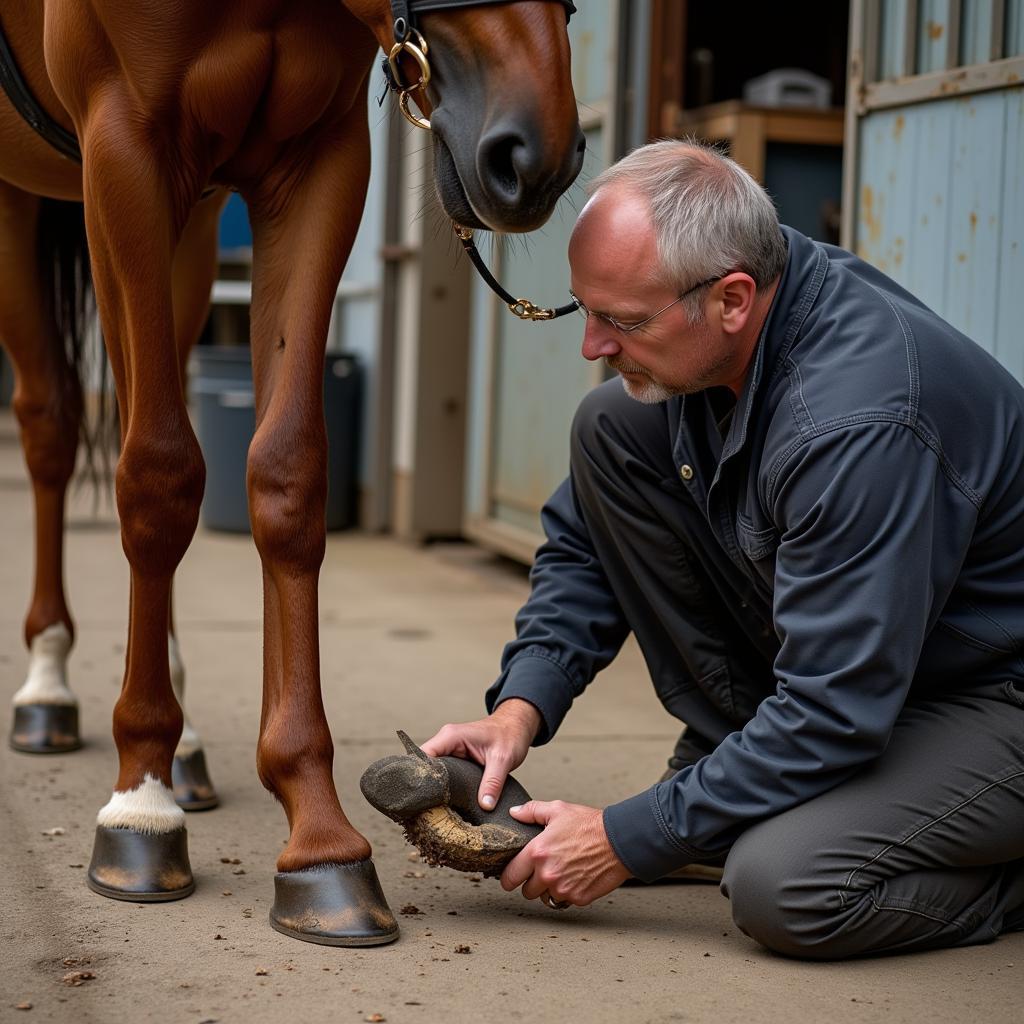Shoe Horse Rings, a critical element of equine care, play a vital role in a horse’s well-being and performance. Understanding the various aspects of shoeing, from the types of shoes available to the importance of proper fitting, is essential for every horse owner. This guide will explore everything you need to know about shoe horse rings, ensuring your horse receives the best possible care.
Understanding the Importance of Shoe Horse Rings
Horseshoes, secured by nails driven through the hoof wall into the white line, protect the hoof from wear and tear, providing support and traction. The shoe horse ring, the metal ring that forms the horseshoe, comes in various sizes and shapes, each designed for specific purposes. Choosing the correct shoe horse ring is crucial for maintaining a horse’s soundness and preventing lameness. Factors such as the horse’s breed, discipline, and individual hoof conformation all influence the choice of horseshoe and, consequently, the shoe horse ring. For instance, a horse used for jumping requires a different shoe horse ring than a horse used for dressage.
Choosing the wrong shoe horse ring can have detrimental effects on the horse. It can lead to imbalances in the hoof, causing uneven weight distribution and potentially leading to lameness. Furthermore, an improperly fitted shoe can cause discomfort and pain, affecting the horse’s gait and overall performance.
Types of Shoe Horse Rings and Their Applications
There is a wide array of shoe horse rings available, each catering to different needs. Some common types include:
- Concave Shoes: These shoes offer excellent grip and are often used for horses working on slippery or uneven terrain.
- Rolled Toe Shoes: Designed to encourage a natural rolling motion of the hoof, these shoes can help prevent tripping and stumbling.
- Bar Shoes: Providing extra support to the heel and frog, bar shoes are often used for horses with navicular disease or other hoof conditions. You can learn more about managing this condition by checking out our article on exercising a horse with navicular.
- Heart Bar Shoes: A specialized type of bar shoe, the heart bar shoe provides additional support to the frog and is often used for horses with laminitis.
Selecting the appropriate shoe horse ring is a complex process that requires the expertise of a farrier. The farrier will assess the horse’s individual needs, considering factors such as hoof conformation, discipline, and any existing hoof conditions.
 Farrier Examining Horse Hoof
Farrier Examining Horse Hoof
The Role of the Farrier in Choosing Shoe Horse Rings
The farrier plays a pivotal role in ensuring the horse’s hooves are properly shod. They are trained to assess the hoof’s conformation, identify any potential problems, and select the most suitable shoe horse ring. Regular farrier visits are essential for maintaining hoof health and preventing lameness. A skilled farrier will not only choose the right shoe horse ring but also ensure it is fitted correctly and balanced, optimizing the horse’s comfort and performance. Remember, proper hoof care is a crucial aspect of responsible horse ownership. You might find our article on navicular horse shoes helpful if your horse suffers from navicular syndrome.
“A well-shod horse is a happy horse,” says John Smith, a certified farrier with over 20 years of experience. “Choosing the right shoe horse ring is paramount to a horse’s soundness and longevity.”
What is the purpose of a shoe horse ring?
A shoe horse ring forms the base of the horseshoe, providing protection and support for the horse’s hoof.
How often should horse shoes be replaced?
Generally, horseshoes should be replaced every 4-8 weeks, depending on the individual horse’s hoof growth and wear.
Common Misconceptions about Shoe Horse Rings
One common misconception is that all horses require shoes. This is not true. Some horses can go barefoot, particularly those with strong, healthy hooves and those who work on softer terrain. Another misconception is that shoeing is painful for the horse. A skilled farrier will ensure the shoeing process is comfortable and does not cause any harm to the horse. If you’re looking for stylish horseshoe-themed accessories, check out our selection of horse shoe bracelets.
Conclusion
Choosing the correct shoe horse ring is a crucial aspect of equine care, impacting a horse’s overall well-being and performance. Understanding the various types of shoes available and the importance of a skilled farrier is essential for every horse owner. By prioritizing hoof care and collaborating with a qualified farrier, you can ensure your horse’s hooves are healthy and well-maintained. For decorative purposes, we also offer a variety of horse shoe wallpaper and horse head with horseshoe designs.
“The right shoe horse ring can make all the difference in a horse’s comfort and performance,” adds Jane Doe, an equine veterinarian with extensive experience in lameness and hoof care. “Investing in proper hoof care is an investment in your horse’s future.”
For any assistance with your horse’s hoof care or if you have questions about shoe horse rings, contact us at Phone Number: 0772127271, Email: [email protected], or visit us at QGM2+WX2, Vị Trung, Vị Thuỷ, Hậu Giang, Việt Nam. We have a 24/7 customer support team ready to assist you.